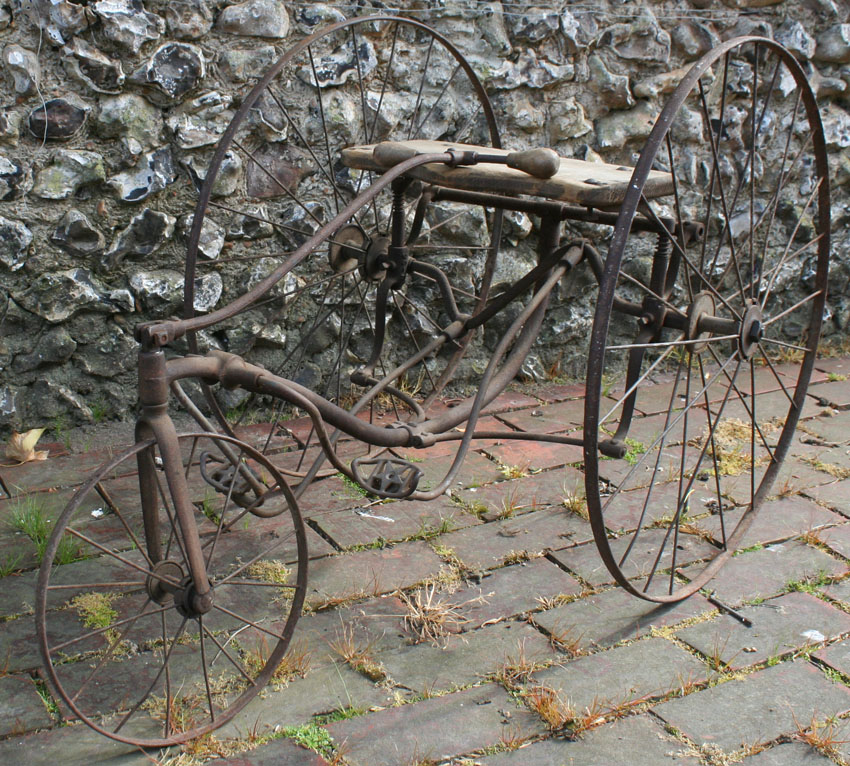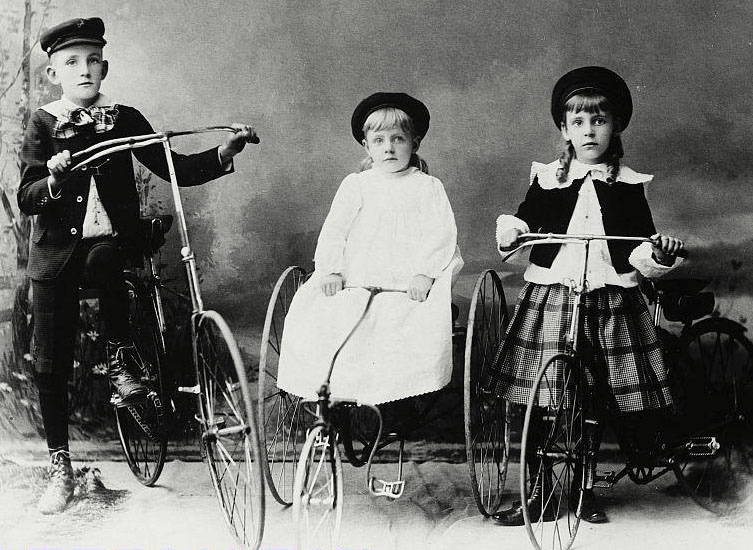

1890s Tiller & Treadle Children’s Tricycle
12″ Front Wheel
24″ Rear Wheels
(Now sold)

This treadle-powered children’s tricycle has 24″ rear wheels and an overall length of 44″. First viewing suggests a relatively primitive design, but closer inspection reveals well-made joints and castings …and rear suspension!
It also has an attractive star design on its pedals, showing that it was not a cheaply-made machine.
This style of children’s tricycle was manufactured from the 1880s, and smaller versions were still being sold up to WW2. They were often bought for children by grandparents nostalgic about their own childhood. Though the first examples had metal rims without tyres, rubber tyre models soon came onto the market too and both were available at different prices.



TILLER & TREADLE TRICYCLE HISTORY

The first velocipede tricycles with driving treadles and tiller steering appear to have been made around 1851. (See the example below at the Science Museum in London). Only one rear wheel was driven, with the other having a brass-bushed hub revolving freely on the driving axle. The wheels were wooden with iron tyres. The one illustrated below has a 24″ front wheel and 35″ rear wheels.

After the invention of the front-wheel driven Velocipede captured the public imagination in 1869, the cycle industry was created. Design evolved and, by 1880, the Ordinary (‘penny farthing’) and the high wheel tricycle ruled the roads.
Treadle-controlled velocipede tricycles for children, such as the one featured here, were made at first by many small manufacturers. They were expensive items in their day, purchased by rich families for their children. Early examples used wooden hubs and parts but, by the 1880s, wheels were made of steel, with cast iron fittings.
The earliest models had metal wheel rims that did not take a tyre but, by the 1880s, steel wheels with solid rubber tyres were offered as an option.
The smaller manufacturers of velocipede tricycles were less likely to fit a head badge, as they normally supplied retailers on a wholesale basis: these sales outlets and distributors included department stores, catalogue companies and local shops, who generally fitted their own badges and often gave the tricycles individual names. This meant that the same tricycle could have a different name at various outlets. Larger manufacturers also supplied these retail outlets, but usually had their own distribution networks and agents too, so were more likely to add their own company names or model names to those sold they sold direct to the public. Popular larger manufacturers included Gendron, Fay, and Kirk.
As you can see from the catalogues below, they marketed tiller & treadle tricycles at girls, while front-driver velocipede tricycles were aimed at boys.

You can see a close-up image in the photo below, from the 1911 Colson catalogue.





Above, a unique star design in the centre of the pedals.
Below: most velocipede tricycle seats had a backrest, either attached to the top of the wooden seat, or as an extension of the rear part of the backbone, which would branch into two parts in front of the axle. This tricycle, however, has a single tube backbone and no seat backrest or fittings for one.

The rear suspension (below) was a feature that was already in use in buggies of the period.


1880s VELOCIPEDE TRICYCLE v 1870s BABY CARRIAGE


BICYCLE v TRICYCLE

Until the advent of the safety bicycle – the first successful ‘rear-driver’ with central pedals was the Premier crossframe in 1886 – women drove tricycles while men rode, first, ‘boneshaker’ velocipedes (above) followed by ordinaries, below. This was a reflection of both the athletic prowess required to ride early bicycles and also conservative dress code of the day: tricycles allowed women to ride with modesty.


























